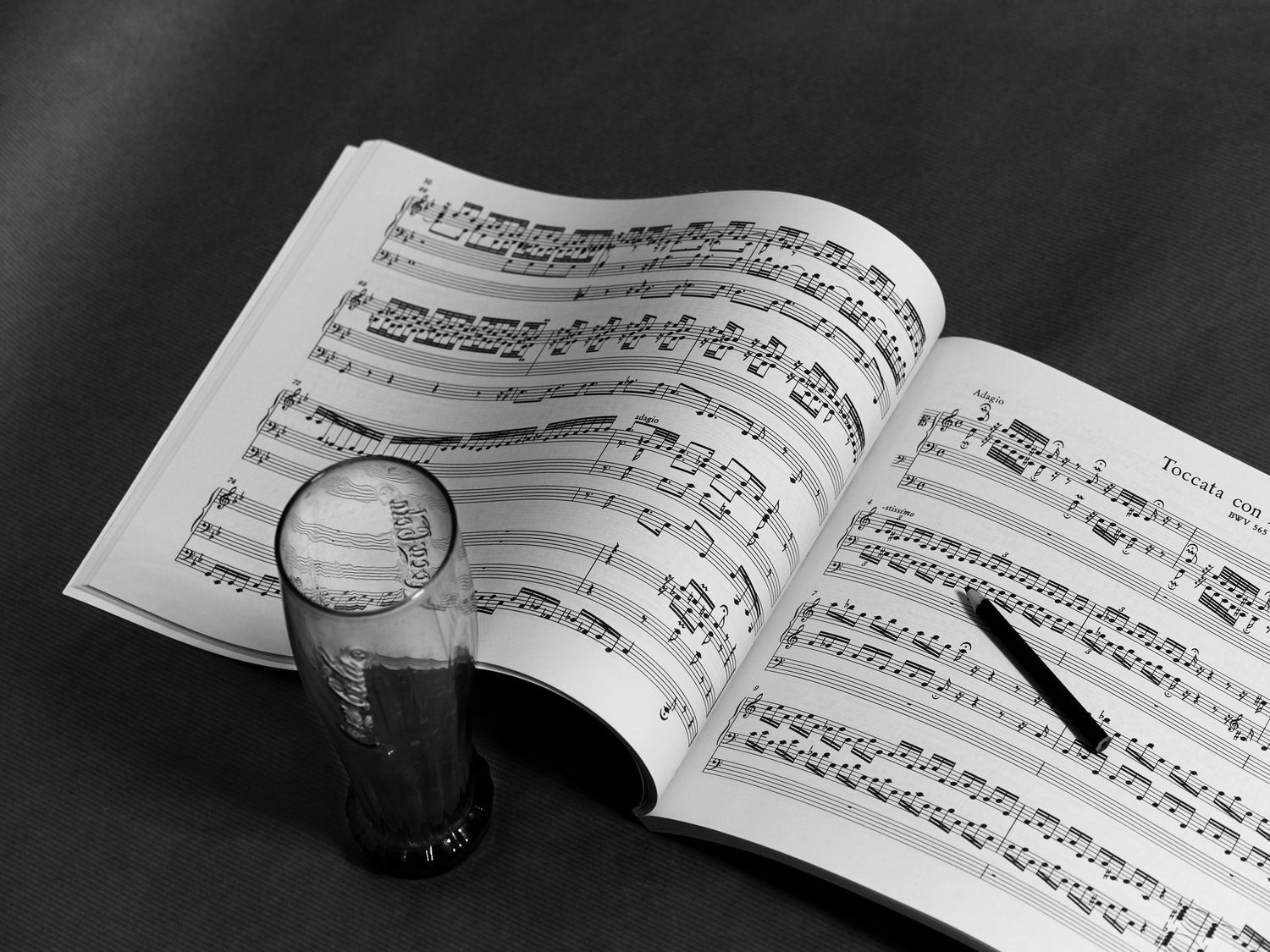Home>Production & Technology>Music Theory>What Do You Learn In Music Theory Class


Music Theory
What Do You Learn In Music Theory Class
Published: January 30, 2024
Discover the key concepts and principles of music theory in our comprehensive music theory class. Expand your understanding of music notation, harmonies, scales, and much more. Enroll today!
(Many of the links in this article redirect to a specific reviewed product. Your purchase of these products through affiliate links helps to generate commission for AudioLover.com, at no extra cost. Learn more)
Table of Contents
Introduction
Welcome to the fascinating world of music theory! Whether you’re an aspiring musician, a music lover, or simply curious about the inner workings of music, studying music theory can provide you with a deeper understanding and appreciation of the art form.
At its core, music theory is the study of how music works. It delves into the fundamental principles and concepts that shape melodies, harmonies, rhythms, and structures. It provides the tools and language to analyze, compose, and communicate musical ideas effectively.
Learning music theory is like unlocking the hidden secrets behind the music you listen to. It allows you to decipher the complexities of a piece, uncover its underlying structure, and comprehend the creative decisions made by the composer. By studying music theory, you will gain insight into the relationships between notes, chords, and rhythms, enabling you to elevate your musical performances and compositions to new heights.
Music theory is not limited to a specific genre or style. Its principles are applicable to classical music, jazz, pop, rock, and everything in between. Whether you’re playing a Mozart symphony, improvising over a jazz standard, or strumming chords on an acoustic guitar, a solid understanding of music theory will enhance your musicality and expand your artistic possibilities.
In this article, we will embark on a journey through the world of music theory, exploring its basics, elements, and applications. We will delve into the mechanics of music notation, unravel the mysteries of scales and key signatures, and dive into the intricacies of chords, harmony, rhythm, and melodic structure. We will also touch upon essential topics such as musical form, analysis, and ear training. By the end of this article, you will have a solid foundation in music theory, equipping you with the knowledge to explore and appreciate music with a trained ear and a discerning mind.
So get ready to dive into the fascinating realm of music theory as we unravel the mysteries behind the beauty and complexity of music!
Basics of Music Theory
Before we delve into the intricate details of music theory, let’s start with the basics. Music theory is built upon a set of foundational concepts that form the framework for understanding how music is organized and created.
One fundamental concept in music theory is the study of pitch. Pitch refers to the perceived highness or lowness of a sound. In Western music, we use a system called the musical alphabet, which consists of the letters A through G. These letters represent specific pitches, and they repeat in a cycle known as an octave. The distance between two pitches is called an interval, and it is measured in steps or half steps.
Rhythm is another essential element of music theory. It refers to the pattern of durations and accents in music. Musical rhythms are typically organized into measures or bars, which contain a specific number of beats. A beat is the basic unit of time in music, and it is usually represented by a steady pulse.
Harmony is the study of how pitches and chords interact. Chords are made up of multiple notes played simultaneously, and they form the harmonic foundation of a piece of music. Understanding chord progressions and harmonic relationships is crucial in analyzing and composing music.
Form is another important aspect of music theory. It refers to the overall structure and organization of a piece of music. Musical forms can range from simple binary forms, where two contrasting sections are repeated, to complex forms like sonata form, which consists of several distinct sections with specific functions and relationships.
These are just a few of the essential concepts covered in the basics of music theory. By studying and understanding these foundational elements, you will gain a solid framework for exploring more advanced topics in music theory.
Next, we will explore the elements that make up music and how they are represented in musical notation. Understanding these elements will provide you with the tools to analyze and compose music effectively.
Elements of Music
Music is an art form that combines various elements to create a unified and expressive composition. Understanding these elements is essential in analyzing and appreciating music on a deeper level.
Melody: Melody is the aspect of music that is easily recognizable and singable. It is a sequence of pitches played or sung one after another, forming a memorable and distinct musical line. Melodies can be simple or complex, weaving through different ranges and intervals to create melodies that evoke different emotions and moods.
Harmony: Harmony is the combination of simultaneous pitches or chords that support and complement the melody. It provides depth and richness to the musical composition. Understanding harmony involves studying how chords are constructed, how they are related to each other, and how they create tension and resolution.
Rhythm: Rhythm is the pattern of musical sounds and silences over time. It is the backbone of music, providing structure, groove, and energy. Rhythm encompasses the durations and accents of individual notes and how they relate to each other. It is what makes us tap our feet, nod our heads, and dance to the music.
Dynamics: Dynamics refers to the volume or intensity of the music. It is the variation in loudness and softness that creates contrast and adds expression to a composition. Dynamics can range from pianissimo (very soft) to fortissimo (very loud), and understanding how to interpret and apply dynamics is crucial in conveying the intended emotions of a piece.
Timbre: Timbre refers to the quality or color of sound produced by different instruments or voices. It is what distinguishes a piano from a trumpet or a soprano from a baritone. Timbre adds character and personality to a musical piece and can greatly influence the overall mood and atmosphere.
Texture: Texture refers to the way the different musical voices or instruments combine and interact with each other. It can be thick and complex, with multiple voices playing simultaneously, or it can be light and sparse, with only a few simple elements. Understanding texture helps in analyzing the overall sound of a composition and how the different elements interact to create a cohesive whole.
Expression: Expression in music involves the interpretation and communication of the composer’s intentions. It includes elements such as articulation, phrasing, and tempo. Expression adds nuance and emotion to the music, allowing performers and listeners to connect with the piece on a deeper level.
By understanding and appreciating these elements, you will develop a more comprehensive and insightful understanding of music. They provide the building blocks to analyze, interpret, and create music, enabling you to delve into the complexities and beauty of musical compositions.
Music Notation
Music notation is the system of writing and representing music on paper. It provides a standardized way to communicate musical ideas, allowing musicians to read and perform compositions accurately. Without music notation, it would be challenging to preserve and transmit musical knowledge from generation to generation.
The basic elements of music notation include the staff, clefs, notes, and various symbols and markings.
The Staff: The staff is a set of horizontal lines and spaces that provide a framework for notating pitches and rhythm. It consists of five lines and four spaces, which represents different pitches. The lines and spaces are numbered from the bottom up, providing a reference for the placement of notes.
Clefs: Clefs are symbols placed at the beginning of the staff to indicate the pitch range of the notes that will be notated. The most commonly used clefs are the treble clef, which is used for higher-pitched instruments and voices, and the bass clef, which is used for lower-pitched instruments and voices.
Notes: Notes are the graphical representations of musical pitches. They are placed on the staff to indicate their specific pitch and duration. The shape and positioning of the note on the staff determine its pitch, while the presence of flags or other symbols indicate its duration. Notes can be placed on the lines or spaces of the staff, and their position can be altered by adding ledger lines above or below the staff for pitches outside of its range.
Rests: Rests are symbols used to represent periods of silence or pauses in the music. Similar to notes, rests come in different shapes and sizes to indicate different durations. They are placed on the staff in the same manner as notes.
Other Symbols and Markings: Music notation includes various symbols and markings to indicate musical instructions, dynamics, articulations, tempo, and more. These symbols help guide the performer in interpreting the music and conveying the intended expression and style.
Learning to read and interpret music notation is a vital skill for musicians. It allows them to study and perform compositions written by others, as well as to transcribe their own musical ideas onto paper. By understanding music notation, musicians can communicate and share their compositions with others across time and space.
Scales and Key Signatures
Scales and key signatures are fundamental concepts in music theory and play a crucial role in understanding the tonal relationships within a piece of music. They provide a framework for creating melodies, forming harmonies, and establishing the tonal center of a composition.
A scale is a collection of pitches arranged in ascending or descending order. It is the foundation upon which melodies and harmonies are built. The most common scale in Western music is the major scale, which consists of seven distinct pitches and follows a specific pattern of whole steps and half steps. The major scale has a bright and uplifting sound and is widely used in various genres and styles of music.
Key signatures are notations placed at the beginning of a staff to indicate the tonal center, or key, of a piece of music. They consist of sharps or flats and are used to establish the tonal relationships between notes. Key signatures tell the performer which notes to play as sharps or flats throughout the composition, eliminating the need to write accidentals (sharps or flats) before each occurrence of the affected note.
The circle of fifths is a useful tool for understanding the relationship between different key signatures. It illustrates how each key is related to its adjacent keys in terms of sharps and flats. Moving clockwise on the circle adds a sharp to the key signature, while moving counterclockwise adds a flat. Key signatures with more sharps or flats can introduce a different flavor or characteristic to the music, and understanding these relationships can aid in composition, improvisation, and transposition.
In addition to the major scale, there are various other scales commonly used in music. These include the natural minor scale, which has a melancholic sound and is the relative minor of the major scale, as well as modes such as the Dorian, Phrygian, and Mixolydian scales, which add unique colors and flavors to compositions.
Understanding scales and key signatures allows musicians to navigate and interpret musical compositions with ease. It enables them to analyze melodies, construct harmonies, and identify tonal relationships within a piece. It also serves as a basis for improvisation and composition, providing a set of predefined notes and tonal relationships to work with.
By mastering scales and key signatures, musicians can unlock the secrets of tonality and open up a world of creativity and musical expression.
Intervals
Intervals are a fundamental concept in music theory that describe the distance between two pitches. They form the building blocks of melodies, harmonies, and chords. Understanding intervals is essential for musicians to understand the relationships between notes and create coherent and compelling musical compositions.
Intervals are named based on the number of letter names they encompass and the number of staff positions they occupy. For example, the interval between C and E is called a third because it spans three letter names (C, D, and E) and occupies three staff positions.
Intervals can be classified as either harmonic or melodic. Harmonic intervals occur when two notes are played or heard simultaneously, while melodic intervals occur when two notes are played or heard sequentially. Each interval has a specific quality or characteristic, which can be major, minor, perfect, augmented, or diminished.
The most common intervals are the perfect unison, which is the same pitch, the octave, which is a duplication of the same pitch but in a higher or lower register, and the perfect fifth, which is a stable and consonant interval often associated with power and stability.
Other intervals, such as the major and minor thirds, major and minor sixths, and major and minor sevenths, both within a major scale and beyond, contribute to the creation of musical tension and release. They form the basis for establishing tonality, constructing chords, and creating melodies that evoke various emotions and moods.
When combined in different ways, intervals can form chords. For example, a major chord consists of a major third and a perfect fifth, while a minor chord consists of a minor third and a perfect fifth. These chords serve as the foundation for harmonies and help shape the overall mood and character of a musical piece.
Interval recognition and understanding are essential for musicians in many aspects of their craft. They aid in sight-reading and transposition, enable the identification of chords and melodies by ear, facilitate improvisation and composition, and provide a framework for analyzing and understanding the structure and tonality of music.
With a solid understanding of intervals, musicians can navigate the intricacies of music with confidence and precision, transforming a series of notes into a captivating and harmonious musical experience.
Chords and Harmony
Chords and harmony are the backbone of music, providing depth, richness, and emotional expression to compositions. Chords are combinations of three or more notes played simultaneously, and they form the harmonic foundation of a piece of music. Understanding chords and harmony is essential for musicians to master the art of creating and interpreting music.
Chords are constructed based on intervals and follow specific patterns. The most common type of chord is the triad, which consists of three notes: the root, third, and fifth. These notes are stacked in thirds, meaning that each note is separated by either a distance of a whole step or a half step.
Chords can be classified into major, minor, diminished, and augmented based on the quality of their intervals. Major chords have a bright and happy sound, while minor chords have a darker and more melancholic quality. Diminished chords create tension and instability, while augmented chords provide a sense of unease or suspense.
Harmony refers to the combination and progression of chords in a musical composition. It involves understanding how chords relate to each other, the principles of chord progressions, and the creation of harmonic structures that support and enhance melodies.
Chord progressions form the backbone of many songs and provide a sense of movement and resolution. Common progressions include the I-IV-V progression, which is prevalent in many popular songs, and the ii-V-I progression, a staple of jazz and classical music. Understanding chord progressions allows musicians to analyze and interpret music more effectively, as well as to create their own original compositions.
Harmony also involves the concept of functional harmony, which refers to the relationships and roles that chords play within a key. Functional harmony distinguishes between chords that provide stability and those that create tension, allowing for the effective use of dissonance and resolution. This understanding of functional harmony helps musicians create compelling and dynamic musical narratives.
By understanding chords and harmony, musicians can create harmonically rich and interesting compositions, improvise with confidence, and interpret and appreciate the nuances of existing musical works. They can analyze the harmonic structure of a piece, identify chord progressions, and explore creative ways to expand and enhance harmonic possibilities.
Developing a strong foundation in chords and harmony provides musicians with the tools to create lush and evocative harmonies and unlock the full potential of music’s expressive power.
Rhythm and Meter
Rhythm is one of the foundational elements of music, providing structure, groove, and energy. It refers to the pattern of durations and accents in music and is essential for establishing a sense of time and creating a compelling musical experience.
Rhythm is typically organized into measures or bars, which contain a specific number of beats. A beat is the basic unit of time in music and is often represented by a steady pulse. Different musical styles have their own characteristic rhythmic patterns, such as the syncopated rhythms of jazz or the driving rhythms of rock and pop music.
Meter is closely related to rhythm and refers to the organization of beats into regular patterns or groupings. The most common meter in Western music is duple meter, which has groups of two beats. Triple meter, with groups of three beats, is also common. Other meters, such as compound meters or irregular meters, add complexity and variety to the rhythmic fabric.
Understanding rhythm and meter allows musicians to perform together effectively. It provides a shared sense of time, allowing performers to coordinate their playing and maintain a consistent groove. It also enables musicians to interpret and convey the intended feel and style of a composition, whether it be a lively dance rhythm or a gentle flowing rhythm.
Rhythmic notation and symbols, such as notes, rests, and time signatures, are used to represent rhythm in written music. These symbols indicate how long a note or rest should be held and provide guidance on how the music should be performed.
Expression and dynamics also play a role in rhythm. Articulation, accents, and other expressive marks can shape the rhythmic interpretation of a piece, adding nuance and subtleties to the rhythm. Varying the dynamics can create tension and release, capturing the listener’s attention and creating a more engaging musical experience.
Developing a strong sense of rhythm and meter is essential for musicians in all disciplines. It allows them to play with precision, communicate effectively with other musicians, and engage the audience with captivating rhythms and grooves. Understanding the intricacies of rhythm and meter enables musicians to infuse their music with life, energy, and expressive power.
Melody and Counterpoint
Melody is the soul of music. It is the memorable and singable part that captures our attention and evokes our emotions. Melodies are sequences of pitches played or sung one after another, forming a distinct musical line. Understanding melody is crucial for musicians to create compelling and memorable musical compositions.
A melody is composed of individual notes that follow a specific sequence and rhythm. Melodies can range from simple and straightforward to intricate and complex. They can be influenced by various factors, including the musical style, genre, and cultural context. Through melody, musicians can express their creativity, convey emotions, and engage listeners in a musical journey.
Counterpoint is the art of combining multiple melodies that are independent but harmonically interrelated. It involves creating harmonically coherent lines that can stand alone as individual melodies while harmonizing with each other when played together. Counterpoint adds depth and complexity to music, creating intricate textures and enhancing the overall musical experience.
There are several principles and techniques that govern counterpoint, such as voice leading, species counterpoint, and contrapuntal devices. Voice leading refers to the smooth and coherent movement of each individual melody line. Species counterpoint provides a structured approach to combining melodies, using different rhythmic and harmonic rules. Contrapuntal devices, such as imitation and canon, add interest and variety to the interplay between melodies.
While counterpoint is often associated with classical music, its principles and techniques are applicable to a wide range of musical genres. Whether in the harmonies of a pop song or the intricate lines of a jazz composition, the skillful use of counterpoint can elevate the musical composition and create a rich and engaging sound.
Understanding melody and counterpoint enables musicians to create captivating and memorable musical experiences. It allows them to craft melodies that resonate with listeners, experiment with harmonically interrelated lines, and explore the complexities of musical textures. The mastery of melody and counterpoint provides the foundation for composing, arranging, improvising, and performing music that touches the hearts and souls of both musicians and audiences.
Musical Form
Musical form refers to the overall structure and organization of a piece of music. It provides a framework that guides the development and flow of musical ideas, creating a coherent and engaging composition. Understanding musical form is essential for musicians to analyze, interpret, and appreciate the structure and narrative of a musical work.
Musical forms can vary in complexity and can be found in various genres and styles of music. Some common forms include binary form, ternary form, theme and variations, sonata form, and rondo form.
Binary Form: Binary form consists of two distinct sections, often labeled as A and B. Each section is usually repeated, resulting in the overall structure of AABB. Binary form creates a sense of contrast between the two sections and is often used in dances or simple songs.
Ternary Form: Ternary form consists of three sections, typically labeled as ABA. The first section, A, presents a theme or musical idea. The second section, B, contrasts with A, often in a different key or mood. The final section, A, returns to the original theme, providing a sense of closure and symmetry.
Theme and Variations: In theme and variations form, a musical theme is introduced in the beginning and is then followed by a series of variations. Each variation explores different musical elements such as melody, harmony, rhythm, or texture while keeping some characteristics of the original theme. Theme and variations form allows composers to showcase their creativity while maintaining a cohesive musical structure.
Sonata Form: Sonata form is a more complex and formal structure often used in classical music. It consists of three main sections: the exposition, development, and recapitulation. The exposition introduces the main musical themes, the development section explores and develops these themes, and the recapitulation restates the themes in their original form. Sonata form provides opportunities for contrast, development, and dramatic tension.
Rondo Form: Rondo form features a recurring theme (A) that alternates with contrasting themes (B, C, D, etc.). The structure of a rondo can be represented as ABACADA, with the A theme serving as the refrain that returns throughout the composition. Rondo form is often characterized by its lively and catchy melodies.
Understanding musical form allows musicians to follow the narrative arc of a composition, recognize recurring themes, and appreciate the balance between contrast and unity. It provides a roadmap for performers and aids in the interpretation and communication of the composer’s intentions.
By analyzing and studying musical form, musicians can gain insights into the compositional choices, understand the emotional trajectory of a piece, and enhance their own compositions by incorporating structural elements effectively. Musical form serves as a guide, leading us through the story that music tells, and allowing us to fully immerse ourselves in the richness and depth of a composition.
Analysis and Ear Training
Analysis and ear training are crucial skills for musicians that deepen their understanding, interpretation, and appreciation of music. These skills involve listening attentively, identifying musical elements, and recognizing relationships within a composition.
Analysis: Musical analysis involves breaking down a piece of music and examining its various components and structural elements. It helps uncover the underlying patterns, harmony, form, and stylistic features that shape the composition. By analyzing music, musicians can gain insights into how a piece is constructed, understand the composer’s intentions, and make informed interpretive decisions when performing or creating their own music.
There are different methods of analysis, including harmonic analysis, which focuses on identifying and understanding the chords and their relationships, and formal analysis, which examines the structure and organization of a piece. Other approaches include thematic analysis, rhythmic analysis, and motivic analysis, which explore various musical elements and their interplay.
Ear Training: Ear training is the development of the ear’s ability to recognize and analyze musical elements. It involves training the brain to identify pitch, intervals, chords, melodies, rhythms, and other musical patterns solely by hearing them. Ear training helps musicians develop a keen sense of musical fluency, allowing them to play by ear, transcribe music, and improvise with greater ease.
Ear training exercises can include identifying intervals by ear, distinguishing major and minor chords, recognizing melodic patterns, and rhythm dictation. These exercises train the ear to perceive the nuances of sound and develop a deep understanding of music.
Analysis and ear training go hand in hand, as analyzing music helps to refine the ear, and ear training enhances analytical skills. Both skills foster a deep connection to the intricacies and beauty of music and help musicians become more expressive, intuitive, and versatile in their musical endeavors.
Beyond the benefits for performers, analysis and ear training also enhance appreciation for music as a listener. By developing these skills, listeners can discern and appreciate the nuances of a composition, recognize the technical and artistic choices made by the composer, and engage with music on a deeper and more profound level.
Overall, analysis and ear training are invaluable tools that enable musicians to unlock the depths of music, cultivate their musicality, and enhance their performance and compositional abilities. They provide a greater appreciation and understanding of music, enriching both the musician’s own musical journey and the experiences of those who listen.
Conclusion
Music theory is a fascinating and essential discipline that enhances our understanding and appreciation of music. From the basics of pitch and rhythm to the intricate concepts of melody, harmony, and form, music theory provides the tools and language to analyze, interpret, and create music. By delving into music theory, musicians gain a deeper insight into the inner workings of music, enabling them to communicate, perform, and compose with greater skill and artistry.
Through the study of music notation, scales, intervals, chords, rhythm, and harmony, musicians develop a solid foundation in music theory. They can decipher complex compositions, analyze the structural elements, and delve into the creative choices made by composers. By understanding the principles of melody and counterpoint, they can craft captivating musical lines and explore the interplay between independent but harmonically related voices.
Music theory is not limited to any particular genre or style. Whether one is studying classical, jazz, rock, or pop, a solid understanding of music theory allows musicians to navigate and express themselves effectively within any musical context. It serves as the common language that unites musicians across different genres and facilitates collaboration and communication.
Furthermore, music theory is not solely for performers. It benefits composers, arrangers, educators, and music enthusiasts alike. Composers can use their knowledge of music theory to craft compelling and well-structured compositions, while educators can use it to guide their students in their musical journeys. Even casual listeners can deepen their enjoyment and engagement with music by understanding the intricacies of music theory.
In conclusion, music theory is an indispensable tool for musicians. It provides the foundation for musical understanding, allowing musicians to analyze, interpret, and create music with depth and intention. Whether exploring the elements of music, unraveling the mysteries of music notation, or diving into the complexities of harmony and form, music theory enriches both the intellectual and emotional aspects of music. So, embrace the power of music theory, and let it guide you on a lifelong journey of musical discovery and expression.











